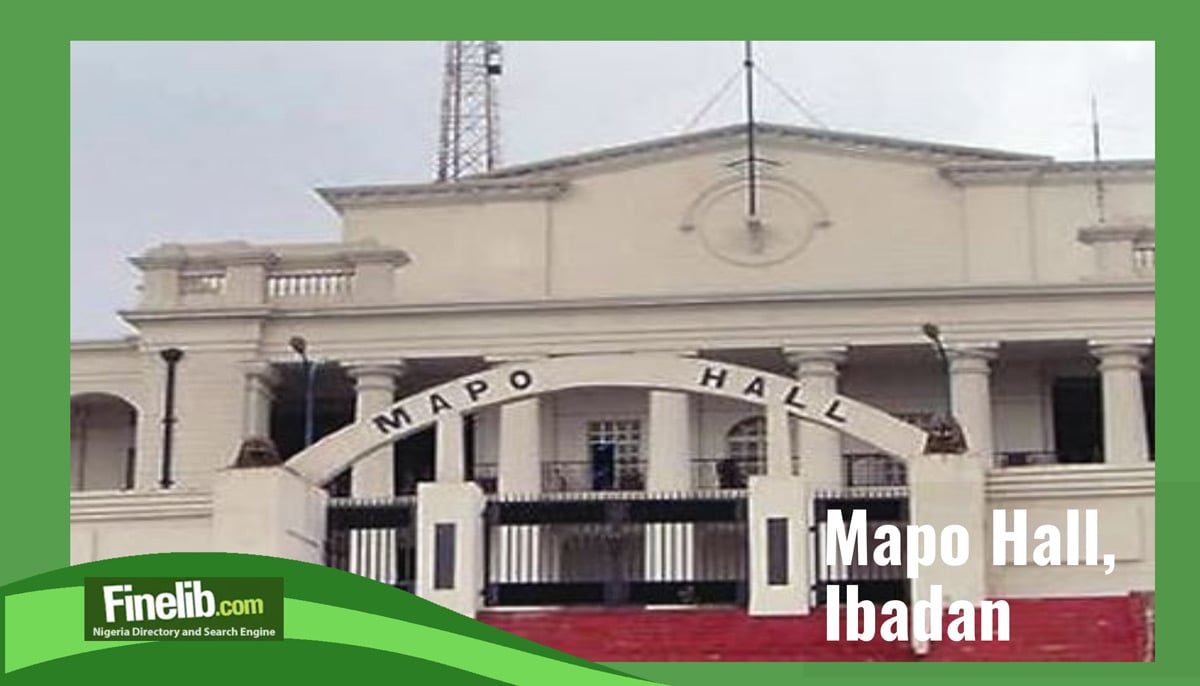Attractions, and History of Mapo Hall Ibadan

If you are on the hunt for a place in Nigeria where history stands tall and culture echoes through time, Mapo Hall in Ibadan is a spot you cannot miss with your mates or kin.
Perched atop Mapo Hill in the heart of Ibadan, Oyo State, this colonial-style city hall rises like a sentinel. Its eight grand pillars and arched gate offer a proper glimpse into Nigeria’s past right in the middle of a bustling Yoruba city.
Known to locals as “Mapo” or “the Hall,” it is a proud landmark that has watched over Ibadan since 1929, a blend of old British flair and Nigerian spirit. Whether you are an Ibadan indigene eager for a taste of your roots or a visitor keen to explore Nigeria’s historic gems, this guide spills the full gist on its story, attractions, and why it remains a must-visit treasure in the southwest. Let’s climb up to this hilltop wonder and uncover what makes it a big deal for all.
The Roots That Built It
Mapo Hall took shape in 1925 when Captain William Alton Ross, the British Resident of Oyo Province, laid its foundation stone, kicking off a dream to anchor Ibadan’s colonial administration with a grand civic hall. Designed by Welsh engineer Robert Taffy Jones, who swapped his homeland for Nigeria’s south in 1910, it rose over four years and was completed in 1929 at £24,000, a hefty sum back then funded by local taxes and labour.
Sir Graeme Thomson, Governor General of Nigeria, officially opened it in August 1929 during the reigns of Oba Shiyanbola Ladigbolu I, the Alaafin of Oyo, and Baale Oyewole, Ibadan’s traditional head, marking it as a bridge between British rule and Yoruba heritage.
Built with native hands, some say prisoners and tax defaulters hauled the bricks. It stood as Nigeria’s nod to St George’s Hall in Liverpool, blending European polish with local sweat. It is a tale of colonial ambition meeting Nigerian resilience, etched into Ibadan’s skyline.
Where It Stands Tall
Mapo Hall crowns Mapo Hill, one of Ibadan’s seven famed hills, smack in the city’s oldest quarter near Ogunmola Street, about 5 kilometres from Ibadan’s modern buzz like Bodija or Ring Road. It overlooks the sprawling red roofs and markets through Oja Oba just below, offering a vantage point that has watched Nigeria’s third-largest city grow across its hilly embrace.
Getting there is no big wahala; from Lagos, hop a bus from Oshodi to Ibadan’s New Garage for about 2000 naira, a 2 to 3-hour ride, then grab an okada or keke to Mapo for 300 nairas more. If you are in Ibadan, a taxi from Dugbe or Mokola costs around 1000 naira straight to the hall’s wide steps, or drive via Mapo Road and spot its pillars rising above the bustle. It is Nigeria’s hilltop watchman, easy to reach yet timeless in its perch.
What Makes It a Wonder
Climb Mapo Hall’s sweeping steps, and you are greeted by eight towering pillars each a giant of plaster and pride framing an arc that spells out its name in bold red letters. Inside, the grand auditorium stretches wide think high ceilings, elegant columns, and Art Deco flair big enough to host hundreds, its walls whispering tales of gatherings past.
A mini museum hides within chains once used on colonial tax dodgers dangle as relics, while photos of every Olubadan from Ibadan’s royal line stare back, a proper nod to Yoruba kingship. Step onto the balcony or roof terrace, and Ibadan unfolds below red roofs, seven hills, and distant markets a view so fine you can snap pics that make your WhatsApp pop. Outside, the Olubadan’s palace sits a short stroll left, while Iba Oluyole’s statue stands proud to the right history hugs this hall tight.
Things to Enjoy There
Mapo Hall is not just for looking it is a spot to soak up with your senses wide open. Wander the auditorium and museum entry is free if you ask nicely and let the staff spill the gist on Ibadan’s colonial days or the kings who shaped its soul.
Bring your suya or puff puff for a picnic on the steps locals often perch there or snap pics from the terrace, catching Ibadan’s sprawl in all its glory. Festivals like Egungun or political rallies turn it loud; drummers and dancers fill the air, so time your visit for a vibe, or go quiet midweek to feel its calm. It is a place to see, touch, and hear Nigeria’s heartbeat.
Why Nigerians Cherish It
Mapo Hall holds a deep pull for Nigeria’s people, especially in Oyo State, where it stands as a proud symbol of Ibadan’s nickname, “the pacesetter,” for leading with grit and grace. Families flock here during festive times like Independence Day, kids chasing the steps while elders share tales of rallies that shook Nigeria’s past.
Students from spots like UI trek up for history lessons. At the same time, locals see Awolowo’s speeches or Azikiwe’s 1955 address as home turf, a daily sight near Mapo Market’s buzz. Tourists love its real Nigerian feel, too, a colonial relic turned cultural hub, offering a taste of Nigeria’s southwest soul. It is a cherished piece of our story, tying yesterday to today.
Getting There and Making It Smooth
Reaching Mapo Hall is a cinch. If you are in Ibadan, a taxi from Sango or Ojoo costs about 1000 naira or a keke from Beere runs 500 nairas straight to Ogunmola Street’s base. From Lagos or Abuja, a 2 to 4-hour bus to Ibadan’s Dugbe park takes 2000 to 3000 naira, and then hop an okada for 300 naira to Mapo Hill’s foot.
It is open daily from 8 a.m. to 6 p.m., with no set entry fee. Though a 500 naira token to staff keeps it smooth, bring cash, as no POS machines linger here. Wear comfy shoes. The steps climb high, and the dry season from November to March is best, with clear skies showing off Ibadan’s hills. Call Ibadan South East LGA ahead (+234 803 576 5899) if you want a guide planning to lift the vibe.
Why It Matters to Nigeria
Mapo Hall is more than a building it is a pillar of Nigeria’s cultural and political tale, born from colonial roots in 1929 to anchor Ibadan’s civic life. It pumps naira into the local flow visitors spend on transport, snacks, and crafts at nearby stalls, boosting vendors while keeping the hall ticking as a heritage hub.
For Nigeria, it is a proud flex. A colonial relic turned Yoruba stronghold, showing the world our knack for blending old rule with new spirit. It inspires too kids to feel history’s weight; adults recall its rallies, all while keeping Nigeria’s story of resilience alive. It is a timeless gift to our nation’s pride.
Tips to Enjoy Your Day
Swing by at 8 a.m. to dodge crowds and pack water or light foods, though hawkers near Mapo Road sell puff puff if you run low, and wear trainers for the steep steps. Bring some naira 500 to 1000 for tips or crafts from roadside stalls—and ask staff for the museum’s best tales; they love to share.
Keep it clean. Do not litter and snap pics from the terrace, but check with staff inside, as some spots are off-limits. With a family, picnic on the steps or wander to Oluyole’s statue. It is a full-day vibe that does not dent your pocket. Time it for a rally if you crave noise. Otherwise, midweek keeps it calm.
Challenges and Bright Futures
Mapo Hall is not without its hiccups. The rainy season from April to October turns roads muddy, slowing your roll up Mapo Hill, and tight funds mean walls peel, or steps crack. Crowds at significant events clog the vibe, parking gets tricky, and power dips can dim the hall’s lights, though generators often kick in.
Hope shines through a 2008 revamp by Governor Alao Akala, who fixed the roof. Whispers of more money could polish the stairs or add signs. If Nigeria invests big, Mapo could glow as a top cultural draw, pulling crowds to Ibadan’s historic core. It is a wonder with grit, ready to rise higher.
Conclusion:
Mapo Hall is Nigeria’s hilltop heartbeat in Ibadan, where colonial bricks weave a tale of Yoruba pride and national hustle across its grand frame. As Nigeria rolls into 2025, it stands as a beacon of heritage and strength, blending old tales with a modern buzz.
It is not just Oyo’s pride. It is a nod to Nigeria’s richness, showing the world we have landmarks worth shouting about. From its 1929 birth to its lively now, it is a story of grit, grace, and glory that keeps Nigeria glowing. It calls you to climb, see, and cherish what makes us unique.




